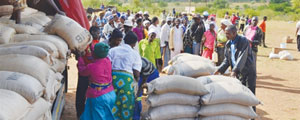
DEPUTY Chief Secretary to the President and Cabinet Christian Katsande yesterday said the country was yet to be self–sufficient in terms of food production despite the improved performance of the agricultural sector last year.
BY PHILLIP CHIDAVAENZI
Katsande, who officially opened the Zero Hunger Review Validation workshop, said several factors beyond the country’s control hampered efforts to ensure the country was food-secure.
“Although there was a marked improvement in the performance of the agricultural sector, and with it the food and nutrition situation last year, the country is yet to regain its self–sufficiency in the major staple cereals,” he said.
“As a result, the country remains exposed to the potent danger of rising international food prices. Droughts and floods frequently affect agricultural production and many households’ access to adequate food.”
Katsande said lack of financial resources was a leading cause of food and nutrition insecurity in the country and over 60% of the country’s households were considered poor, with those in the rural areas hardest hit at 76%.
He highlighted that the problems manifested more in children and although Zimbabwe had managed to maintain the level of wasting among children under the age of five at 5%, which was within the internationally acceptable level, there was still a struggle to lower the levels.
He said in 1999, underweight children made up 10% of the six to 59 months’ age group, but the number scaled up to 13% in 2005 before declining to 10% in 2010 and rising again in 2014 to 11%. “The prevalence of stunted children aged less than five years has remained in the unacceptable range of above 30% between 1999 and 2010,” he said.
- Chamisa under fire over US$120K donation
- Mavhunga puts DeMbare into Chibuku quarterfinals
- Pension funds bet on Cabora Bassa oilfields
- Councils defy govt fire tender directive
Keep Reading
“In 2014, the proportion of stunted children declined to 28% and it is too early to celebrate this decline as more data points are required in future to ascertain the trend.”
The workshop followed the completion of a strategic review of Zimbabwe’s efforts towards implementing the Zero Hunger Challenge (ZHC) conducted by Women’s University in Africa Vice Chancellor Professor Hope Sadza.
The review is expected to reshape World Food Programme (WFP)’s strategic planning process and focus for its Zimbabwe country programme. The ZHC’s main purpose was to accelerate the progress towards eliminating food insecurity and malnutrition in the country.











